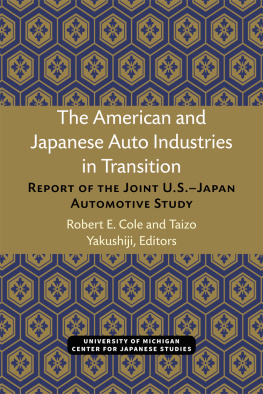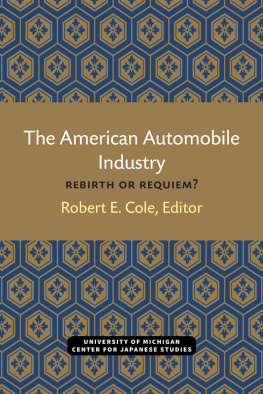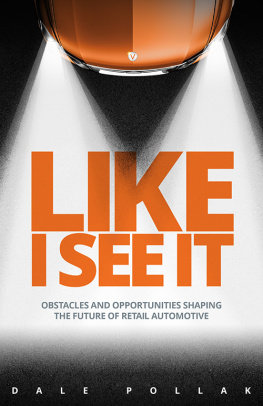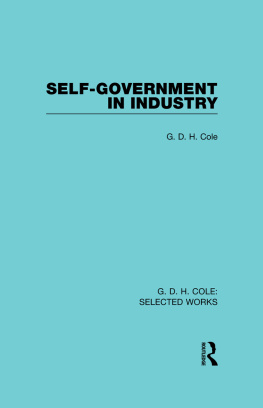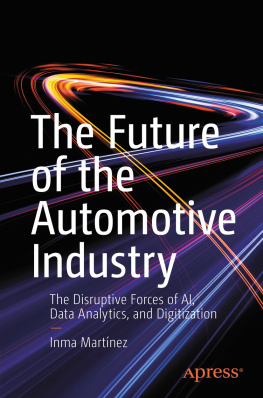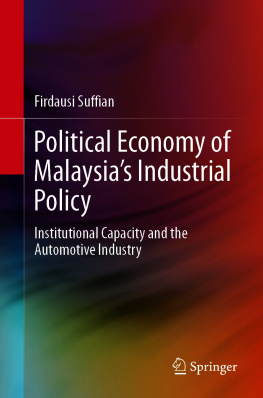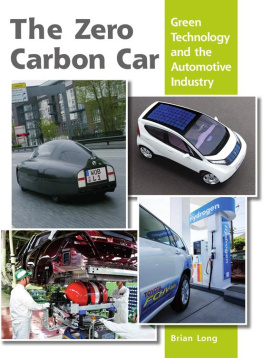Robert E. Cole - The Japanese Automotive Industry: Model and Challenge for the Future?
Here you can read online Robert E. Cole - The Japanese Automotive Industry: Model and Challenge for the Future? full text of the book (entire story) in english for free. Download pdf and epub, get meaning, cover and reviews about this ebook. year: 2020, publisher: Creative Commons Attribution-NonCommercial-NoDerivatives 4.0 International license, genre: Romance novel. Description of the work, (preface) as well as reviews are available. Best literature library LitArk.com created for fans of good reading and offers a wide selection of genres:
Romance novel
Science fiction
Adventure
Detective
Science
History
Home and family
Prose
Art
Politics
Computer
Non-fiction
Religion
Business
Children
Humor
Choose a favorite category and find really read worthwhile books. Enjoy immersion in the world of imagination, feel the emotions of the characters or learn something new for yourself, make an fascinating discovery.
- Book:The Japanese Automotive Industry: Model and Challenge for the Future?
- Author:
- Publisher:Creative Commons Attribution-NonCommercial-NoDerivatives 4.0 International license
- Genre:
- Year:2020
- Rating:5 / 5
- Favourites:Add to favourites
- Your mark:
- 100
- 1
- 2
- 3
- 4
- 5
The Japanese Automotive Industry: Model and Challenge for the Future?: summary, description and annotation
We offer to read an annotation, description, summary or preface (depends on what the author of the book "The Japanese Automotive Industry: Model and Challenge for the Future?" wrote himself). If you haven't found the necessary information about the book — write in the comments, we will try to find it.
The Japanese Automotive Industry: Model and Challenge for the Future? — read online for free the complete book (whole text) full work
Below is the text of the book, divided by pages. System saving the place of the last page read, allows you to conveniently read the book "The Japanese Automotive Industry: Model and Challenge for the Future?" online for free, without having to search again every time where you left off. Put a bookmark, and you can go to the page where you finished reading at any time.
Font size:
Interval:
Bookmark:

THE UNIVERSITY OF MICHIGAN CENTER FOR JAPANESE STUDIES
MICHIGAN PAPERS IN JAPANESE STUDIES
NO. 3
THE JAPANESE AUTOMOTIVE INDUSTRY: MODEL AND CHALLENGE FOR THE FUTURE?
Edited by
Robert E. Cole
Ann Arbor
Center for Japanese Studies
The University of Michigan
1981
Open access edition funded by the National Endowment for the Humanities/Andrew W. Mellon Foundation Humanities Open Book Program.
Copyright 1981
by
Center for Japanese Studies
The University of Michigan
Library of Congress Cataloging in Publication Data
Main entry under title:
The Japanese automotive industry.
(Michigan papers in Japanese studies: no. 3)
1. Automobile industry and tradeJapanAddresses, essays, lectures. I. Cole, Robert E. II. University of Michigan. Center for Japanese studies. III. Series.
HD9710.J32J37 338.4762920952 81-6185
ISBN 0-939512-08-4 AACR2
Printed in the United States of America
ISBN 978-0-93-951208-9 (paper)
ISBN 978-0-47-288004-1 (ebook)
ISBN 978-0-47-290203-3 (open access)
The text of this book is licensed under a Creative Commons Attribution-NonCommercial-NoDerivatives 4.0 International License: https://creativecommons.org/licenses/by-nc-nd/4.0/
TABLE OF CONTENTS
Robert E. Cole
Harold T. Shapiro
Paul W. McCracken
Neil Goldschmidt
Yasuhiko Suzuki
Donald Ephlin
David S. Potter
Fred G. Secrest
Donald W. Riegle, Jr.
Ira C. Magaziner
Robert E. Cole
David E. Cole
John Schnapp
As those of us at the Center for Japanese Studies reflected on the deteriorating position of the domestic auto industry in the fall of 1980, and the strong competitive threat being posed by the Japanese automakers, we were struck by the extraordinarily low quality of the public discussion of these critical issues. The national importance of the issues seemed only matched by the superficiality of the analyses being offered. The tendency to think in terms of scapegoats was particularly evident. The Japanese as the basic cause of our problems has been a particularly notable theme. To be sure, cooperation with the Japanese in formulating a rational overall trade policy may be an important part of the solution. It has also been fashionable to blame it all on American auto industry management for not concentrating on the production of small cars when everyone knew that was the thing to do. Alternatively, government meddling was blamed for all our problems. Clearly, the complex problem we faced required more penetrating analyses. It seemed to us therefore that the time was ripe for a public seminar which moved beyond the rhetoric of the moment and probed some of the deeper causes of our problems and possible directions for future policy.
Consider the increase in unemployment among auto workers which has provoked much of the growing public sentiment in America to take political action. To attribute this unemployment simply to the Japanese market penetration, or to the derelictions of our own industry and workers, or to misguided government policies confesses some ignorance of current market conditions and production developments affecting present and future employment opportunities in the domestic auto industry. The internationalization of the auto market, the industrys trend toward worldwide sourcing, growing automation, and the shift to smaller cars which use less materials all presage a sizeable permanent reduction of the labor force employed to produce cars. These processes operate for the most part independent of Japanese market penetration. To give a sense of the magnitude of these developments, according to one industry projection, by 1985 we will be sourcing 25 percent (in dollar value) of auto components outside of the United States.
Moreover, much of the impact of unemployment will be concentrated in the five major auto states: Michigan, Ohio, Indiana, New York, and Illinois. The movement toward lighter materials such as aluminum as well as the increasing emphasis on electronics all create employment opportunities outside the industrys traditional midwestern heartland; the reduction in use of such materials as cast iron will dramatically reduce employment in the midwestern foundries. Proposed accelerated depreciation schedules for capital investment and other tax policies as well as expected increases in new plant investment also encourage geographical diversification. Outmigration from the affected region will surely occur, but unemployment and its attendant misfortunes will still be severe and may be ameliorated only by major efforts. There is no guarantee of federal relief, and no guarantee that even if such relief were available needed basic adjustments would quickly occur. Some state treasuries are presently hardpressed, Michigans among them.
In holding the January 1981 auto conference, we took it as our task to begin addressing the critical issues facing the industry, with particular, but not exclusive, attention to examining the role of the Japanese auto industry. We had in mind not simply to conduct a rational discussion of the trade issue but to probe the sources of Japanese competitive strength, especially those features whose study might profit us.
Americans have not had very good access to information on Japanese industry, an ignorance imposed principally by the cultural and language barrier between the two countries. Some rather simplistic formulations of the sources of Japanese strength and the lessons to be learned having gained currency on both sides of the Pacific, a serious dialogue on the central issues appeared timely. Reflecting on the public seminar and the articles presented in this volume, we can hardly be satisfied with our success. In some respects, we may even have contributed to establishing some new myths. Nevertheless, critical issues were explored and important information presented. Much remains to be done; by the Center for Japanese Studies and the University of Michigan, for one, in nurturing what useful and clearly needed beginnings were made.
I would like to thank Harold Shapiro, President of the University, for his strong support for the plan to hold the seminar, and David Cole, Director of the Office for the Study of Automotive Transportation, Donald Smith, Director of the Industrial Development Division, and Al Sussman, Dean of the Rackham School of Graduate Studies, who served with me on the planning committee. David Stark performed heroically as conference coordinator. Numerous others gave unstintingly of their time and expertise.
Those who attended the public seminar can testify to the almost electric atmosphere throughout the day. The strong need for good information upon which to base policy was apparent. The seminar received national attention in the analyses of such respected journals as Wards Automotive Report and Science.
In these proceedings, we bring those discussions to a wider audience. Question and answer sessions at the conference were necessarily short and a few speakers delivered abbreviated remarks; this volume restores a number of omissions, and provides additional answers to some pertinent questions put by our audience. We hope to encourage the serious problem-solving these complex issues demand. Far too much time has been spent trying to fix the blame.
Robert E. Cole
Director
Center for Japanese Studies
Harold T. Shapiro
It is a pleasure to welcome you all to the University of Michigan and to this important conference. I would like to extend a special welcome to todays speakers and, in particular, to Secretary of Transportation Neil E. Goldschmidt and to Senators Carl M. Levin and Donald W. Riegle, Jr. Their presence here today bears witness to their deep concern regarding the matters before us today, and to their commitment, both to the State of Michigan and to the restructuring and reinvigoration of the national economy. I would also like to thank my colleagues here at the University of Michigan who, by serving on the planning committee, have managed to bring an initial idea regarding the conference to its fruition here today. The timeliness of the discussions that we will hear today is borne witness to by the extraordinary public interest in this conference and an actual attendance far in excess of what we had anticipated.
Font size:
Interval:
Bookmark:
Similar books «The Japanese Automotive Industry: Model and Challenge for the Future?»
Look at similar books to The Japanese Automotive Industry: Model and Challenge for the Future?. We have selected literature similar in name and meaning in the hope of providing readers with more options to find new, interesting, not yet read works.
Discussion, reviews of the book The Japanese Automotive Industry: Model and Challenge for the Future? and just readers' own opinions. Leave your comments, write what you think about the work, its meaning or the main characters. Specify what exactly you liked and what you didn't like, and why you think so.


